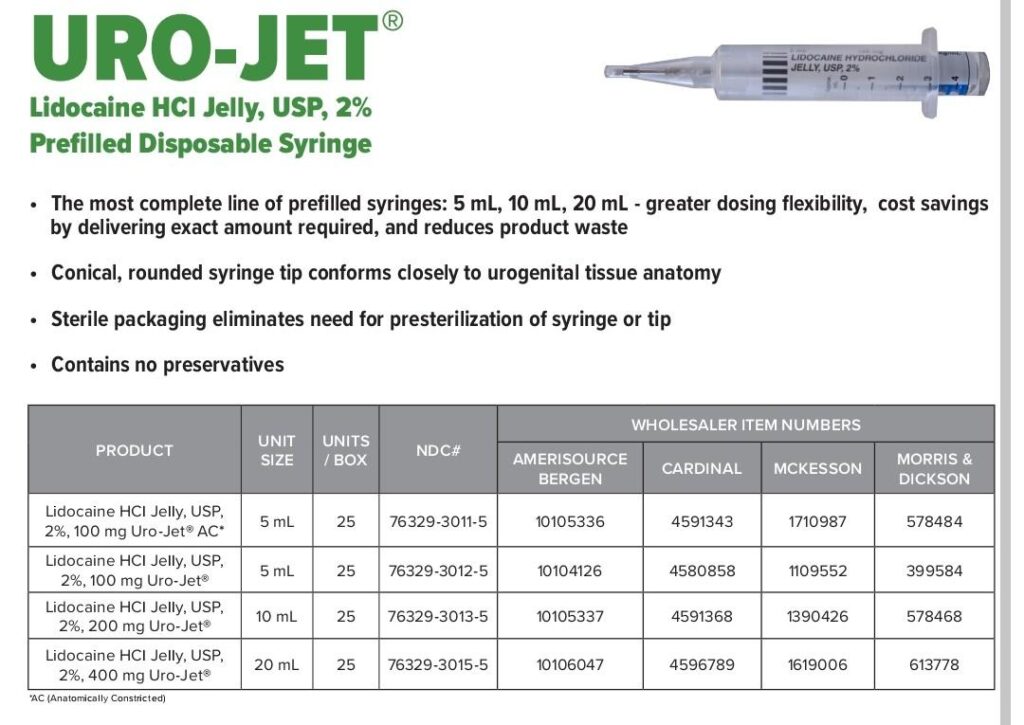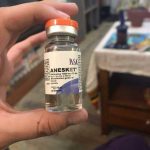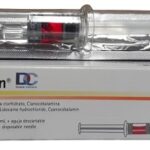URO-Jet: Uses, Dosage, Side Effects, Warnings

URO-Jet jelly is a local anesthetic containing Lidocaine Hydrochloride Jelly USP, 2% administered topically. This product contains no preservative and any unused portion should be discarded after initial use.
Lidocaine Hydrochloride Jelly USP, 2% is indicated for prevention and control of pain in procedures involving the male and female urethra for topical treatment of painful urethritis, and as an anesthetic lubricant for endotracheal intubation (oral and nasal).
How URO-Jet works
Lidocaine stabilizes the neuronal membrane by inhibiting the ionic fluxes required for the initiation and conduction of impulses, thereby effecting local anesthetic action.
Onset of action: The onset of action is 3-5 minutes. It is ineffective when applied to intact skin. Excessive blood levels may cause changes in cardiac output, total peripheral resistance, and mean arterial pressure. These changes may be attributable to a direct depressant effect of the local anesthetic agent on various components of the cardiovascular system.
Lidocaine may be absorbed following topical administration to mucous membranes, its rate and extent of absorption varies depending upon concentration and total dose administered, the specific site of application and duration of exposure.
In general, the rate of absorption of local anesthetic agents following topical application occurs most rapidly after intratracheal administration. Lidocaine is also well-absorbed from the gastrointestinal tract, but little intact drug may appear in the circulation because of biotransformation in the liver. Lidocaine is metabolized rapidly by the liver, and metabolites and unchanged drug are excreted by the kidneys. Approximately, 90% of lidocaine administered is excreted in the form of various metabolites, and less than 10% is excreted unchanged. The primary metabolite in urine is a conjugate of 4-hydroxy-2, 6-dimethylaniline. The plasma binding of lidocaine is dependent on drug concentration, and the fraction bound decreases with increasing concentration. At concentrations of 1 to 4 μg of free base per mL, 60 to 80 percent of lidocaine is protein bound. Binding is also dependent on the plasma concentration of the alpha-I-acid glycoprotein. Lidocaine crosses the blood-brain and placental barriers, presumably by passive diffusion. Studies of lidocaine metabolism following intravenous bolus injections have shown that the elimination half-life of this agent is typically 1.5 to 2 hours. Because of the rapid rate at which lidocaine is metabolized, any condition that affects liver function may alter lidocaine kinetics. The half-life may be prolonged two-fold or more in patients with liver dysfunction.
Who should not use URO-Jet?
Lidocaine is contraindicated in patients with a known history of hypersensitivity to local anesthetics of the amide type or to other components of Lidocaine Hydrochloride Jelly USP, 2%. Lidocaine Hydrochloride Jelly USP, 2% should be used with extreme caution in the presence of sepsis or severely traumatized mucosa in the area of application, since under such conditions there is the potential for rapid systemic absorption.
When used for endotracheal tube lubrication, care should be taken to avoid introducing the product into the lumen of the tube. Do not use the jelly to lubricate the endotracheal stylettes. lf allowed into the inner lumen, the jelly may dry on the inner surface leaving a residue which tends to clump with flexion, narrowing the lumen. There have been rare reports in which this residue has caused the lumen to occlude.

How is URO-Jet used?
Read and follow all directions on the product package before using this medication. When Lidocaine Hydrochloride Jelly USP, 2% is used concomitantly with other products containing lidocaine, the total dose contributed by all formulations must be kept in mind. The dosage varies and depends upon the area to be anesthetized, vascularity of the tissues, individual tolerance, and the technique of anesthesia. The lowest dosage needed to provide effective anesthesia should be administered.
Dosages should be reduced for children and for elderly and debilitated patients. Although the incidence of adverse effects with Lidocaine Hydrochloride Jelly USP, 2% is quite low, caution should be exercised, particularly when employing large amounts, since the incidence of adverse effects is directly proportional to the total dose of local anesthetic agent administered.
For surface anesthesia of the male adult urethra: The outer orifice is washed and disinfected. The plastic tip is introduced into the orifice, where it is firmly held in position. The jelly is instilled by an easy syringe-like action, until the patient has a feeling of tension or until about 15 mL (i.e., 300 mg of lidocaine hydrochloride) is instilled. A penile clamp is then applied for several minutes at the corona and then additional jelly (about 15 mL) is instilled.
To save time, the injection is performed against the resistance of the sphincter, possibly assisted by asking the patient to strain as for defecation or to press as in voiding. The jelly will then pass into the posterior urethra. Prior to sounding or cystoscopy, a penile clamp should be applied for 5 to 10 minutes to obtain adequate anesthesia. If the instrument is introduced immediately, a lubricant is unnecessary.
Otherwise some jelly can be expressed from the vial and applied to the instrument tip. About 30 mL (i.e., 600 mg) may be required to fill and dilate the male urethra. When it is desired to anesthetize only the anterior male urethra, as prior to catheterization, considerably smaller volumes, such as the contents from a 5 mL (i.e., 100 mg) or 10 mL (i.e., 200 mg) size vial, are usually adequate for lubrication.
For surface anesthesia of the female adult urethra: 3 to 5 mL of the jelly is instilled slowly into the urethra by gently expressing the contents of the vial. If desired, some jelly may be deposited on a cotton swab and introduced into the urethra. In order to obtain adequate anesthesia, several minutes should be allowed prior to performing urological procedures. Lubrication for endotracheal intubation: Apply a moderate amount of jelly to the external surface of the endotracheal tube shortly before use. Care should be taken to avoid introducing the product into the lumen of the tube. Do not use the jelly to lubricate endotracheal stylettes.
MAXIMUM DOSAGE: No more than 600 mg of lidocaine hydrochloride should be given in any 12 hour period.
Children: It is difficult to recommend a maximum dose of any drug for children since this varies as a function of age and weight. For children Iess than ten years who have a normal Iean body mass and a normal Iean body development, the maximum dose may be determined by the application of one of the standard pediatric drug formulas (e.g., Clark’s rule). For example, in a child of five years weighing 50 Ibs., the dose of lidocaine hydrochloride should not exceed 75-100 mg when calculated according to Clark’s rule. In any case, the maximum amount of lidocaine administered should not exceed 4.5 mg / kg (2 mg / lb) of body weight.
What are some side effects of URO-Jet that I need to call my doctor about right away?
Even though it may be rare, some people may have very bad and sometimes deadly side effects when taking a drug. Tell your doctor or get medical help right away if you have any of the following signs or symptoms that may be related to a very bad side effect:
• Signs of an allergic reaction, like rash; hives; itching; red, swollen, blistered, or peeling skin with or without fever; wheezing; tightness in the chest or throat; trouble breathing, swallowing, or talking; unusual hoarseness; or swelling of the mouth, face, lips, tongue, or throat.
• Signs of infection like fever, chills, very bad sore throat, ear or sinus pain, cough, more sputum or change in color of sputum, pain with passing urine, mouth sores, or wound that will not heal.
• Signs of too much acid in the blood (acidosis) like confusion; fast breathing; fast heartbeat; a heartbeat that does not feel normal; very bad stomach pain, upset stomach, or throwing up; feeling very sleepy; shortness of breath; or feeling very tired or weak.
• Signs of methemoglobinemia like a blue or gray color of the lips, nails, or skin; a heartbeat that does not feel normal; seizures; very bad dizziness or passing out; very bad headache; feeling very sleepy; feeling tired or weak; or shortness of breath. This effect is rare but may be deadly if it happens.
• Trouble breathing, slow breathing, or shallow breathing.
• Very bad numbness and tingling.
• Feeling lightheaded, sleepy, confused, or having blurred eyesight.
• Seizures.
• Change in eyesight.
• Feeling nervous and excitable.
• Dizziness or passing out.
• Ringing in ears.
• Upset stomach or throwing up.
• Feeling hot or cold.
• Shakiness.
• Twitching.
• Slow heartbeat.
• Chest pain.
Store at:15° to 30°C (59° to 86°).





